The coastal road leading to Mandraki branches off at Mandraki and climbs up a dirt road that is easy to walk on to the women’s monastery of St. Nicholas, which visitors reach after a walk of about 1 hour. The monastery is located in a beautiful spot, surrounded by a large olive grove, and is dedicated to the patron saint of the village, St. Nicholas.
The monastery is located in a beautiful spot, surrounded by a large olive grove, and is dedicated to the patron saint of the village, St. Nicholas.
It is located on the hill of Mount Ompori, about one kilometer from the Holy Monastery of the Holy Trinity. The Holy Temple is Byzantine in style with an octagonal dome and sacred icons on a new wooden iconostasis.
The Holy Temple is Byzantine in style with an octagonal dome, and the sacred icons of the wood-carved iconostasis, which is new, are old and of great Byzantine art, dating back to the 17th century.
During the Ottoman occupation and after liberation, the monastery flourished and many brothers practiced asceticism and were blessed by the protection and blessing of Saint Nicholas. At that time, the island of Trikeri was donated to the Holy Monastery.
After the war of 1940, the monastery fell into decline. Its last “champion” was the blessed monk Arsenios Vetimis from Hydra, who lived there for about thirty years.
In 1983, the monastery, which had been deserted after the death of the monk Arsenios, was converted into a convent, and with the blessing and support of the Church, its complete renovation began.
The holy church of Saint Nicholas was completely renovated, while all the areas of the monastery were beautified and refurbished in a remarkable way. The piety and assistance of the people of Hydra and other pilgrims in the renovation of the monastery was truly moving.
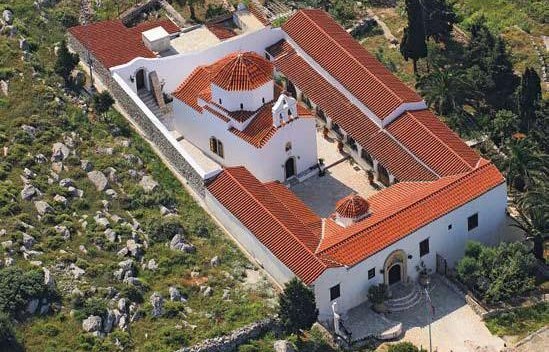
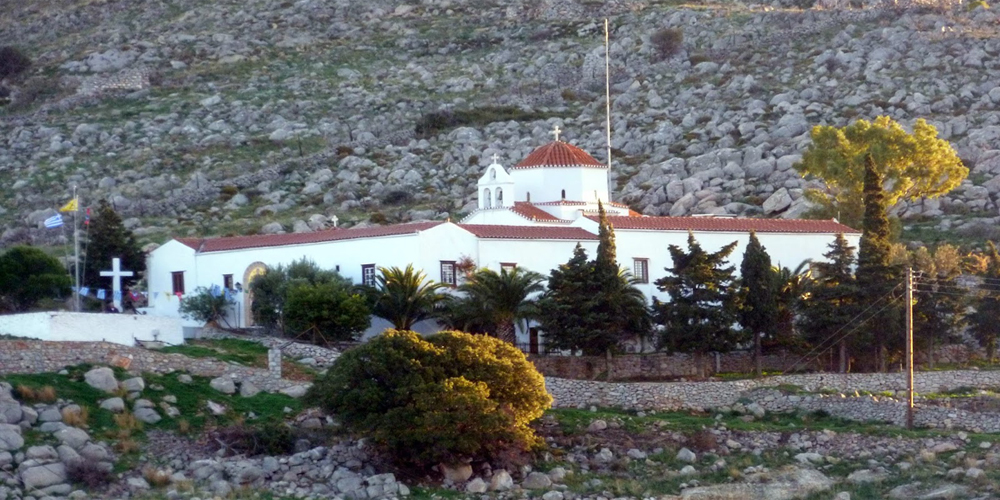
Holy Monastery of Saint Nicholas, Hydra, 18040
Monastery telephone number: 22980 – 52551
Visiting hours: by telephone arrangement
Feast day: December 6, feast of Saint Nicholas
The route from Hydra beach to the Monastery of Agia Triada takes about 55 minutes. At the beach, the first road (at Alphabank) on the left leads to the stadium and then to the pine-covered area of the Monastery of Agia Fotini. From Agia Fotini, we take a dirt path and after a short while we arrive at ‘Mylos’, an 18th-century stone building that was once a wheat processing plant. At this point, the road splits into two paths, which lead to the monasteries of Agia Matrona and Agia Triada.
The Monastery of Agia Triada is built on the top of the mountain, where the road built by the Council of Elders of Hydra in the 18th century ended.
The monastery was built in 1704 by the priest Antonios Oikonomou. Antonios left his entire estate to the Monastery of Agia Triada in his will in 1736.
Parthenios was abbot at the end of the 18th century, and Chrysanthos Karatzas (1839-1884) was the one who repaired the monastery after it had fallen into ruin and purchased the land around it. During the revolution of 1821, the Monastery of the Holy Trinity offered financial support to the struggling Greeks. In 1825, Tsamis Karatasos fortified the monastery to repel any invasion. In 1915, a violent storm caused terrible damage to the Holy Trinity Monastery, destroying the dome and a large part of the roof of the katholikon. The damage to the monastery was repaired at his own expense in 1916 by the great Hydra benefactor.
Parthenios was abbot at the end of the 18th century, and Chrysanthos Karatzas (1839-1884) was the one who repaired the monastery after it had fallen into ruin and purchased the land surrounding it. During the revolution of 1821, the Monastery of the Holy Trinity offered financial support to the struggling Greeks. In 1825, Tsamis Karatasos fortified the monastery to repel any invasion. In 1915, a violent storm caused terrible damage to the Holy Trinity Monastery, destroying the dome and a large part of the roof of the katholikon. The damage to the monastery was repaired at his own expense in 1916 by the great Hydra benefactor Gikas N. Koulouras.
Between 1970 and 1974, the Holy Monastery of Agia Triada was renovated under the supervision of the late Metropolitan Hierotheos of Hydra, and at that time it was converted into a House of Pastoral Ministry.
The monastery complex has the characteristics of an Orthodox monastery, with a Byzantine-style church in the middle and buildings around it, an arched entrance, a garden, buildings with a dining room, a library, cells, a guesthouse, etc. The icons in the church were probably painted by the Hydra iconographer Karatzas.
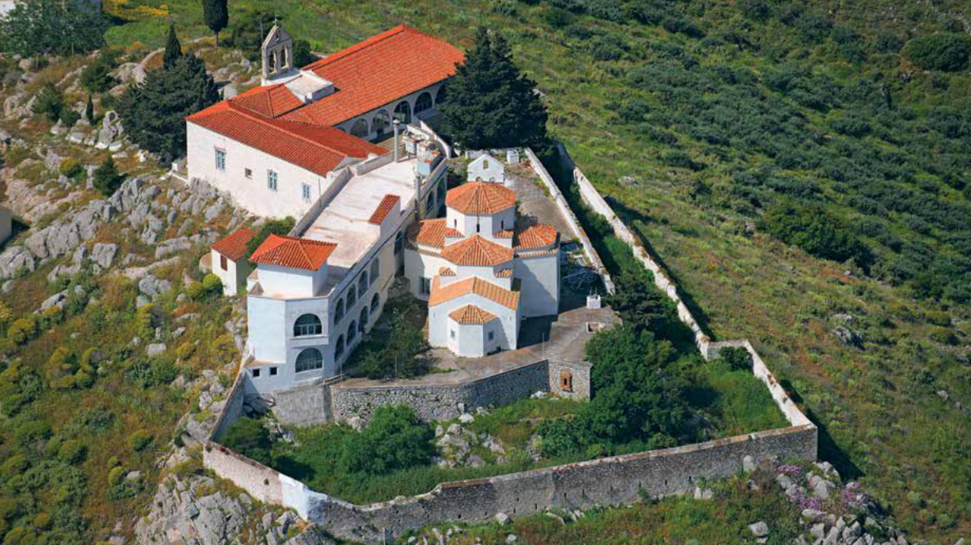
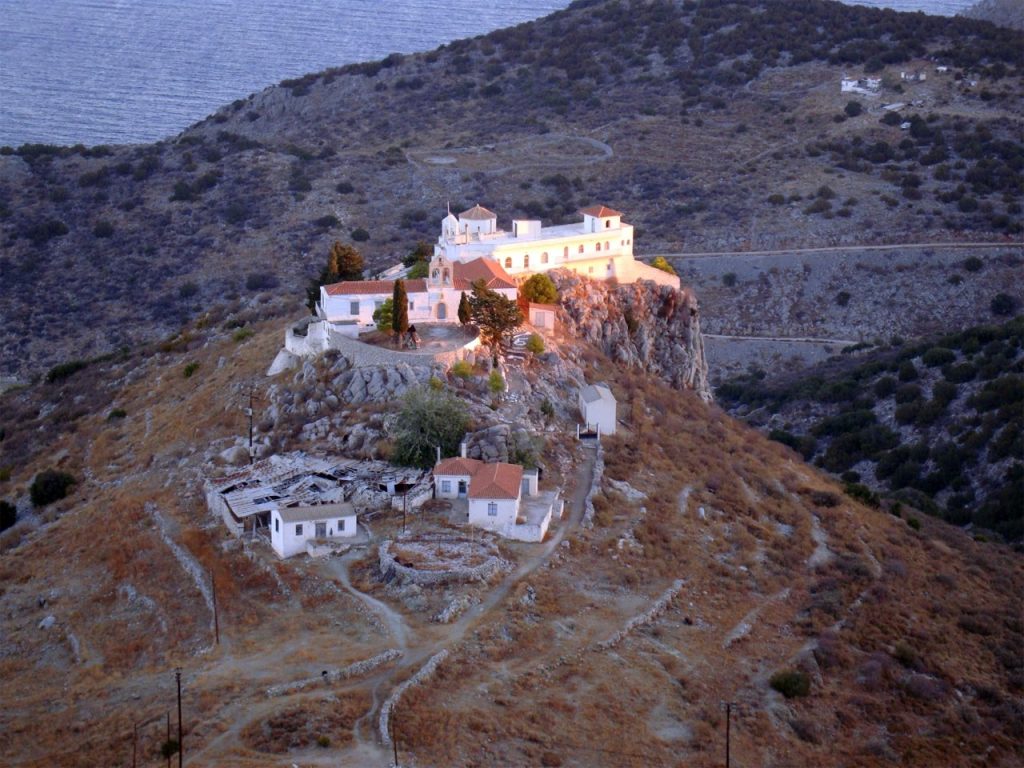
Holy Monastery of the Holy Trinity, Hydra, 18040
Monastery telephone number: 22980-52553
Feast day on the feast of the Holy Spirit
The route from Hydra beach to the Monastery of Agia Matrona takes about 40 minutes. On the beach, after the flying dolphins, the first road on the left, at the first corner of the port (at the “My Crown” exhibition space), leads you to the stadium and then to the pine-covered area of the Monastery of Agia Fotini.
From Agia Fotini, take a dirt path and after a short walk you will reach ‘Mylos’, an 18th-century stone building that was once a wheat processing plant. At this point, the road splits into two paths, which lead to the monasteries of Agia Matrona and Agia Triada.
The Holy Monastery of Agia Matrona, located 15 minutes from the Monastery of Agia Triada, is a women’s monastery on Mount Karessa and celebrates its feast day on October 20. It was founded by Chrysanthos Karatzas in 1865.
The monastery complex also includes the church of Agios Sozon, an additional gem on the inaccessible slope of Mount Karessa.
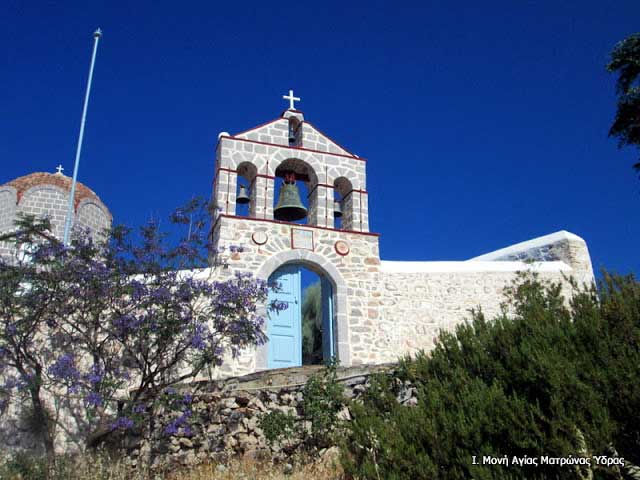
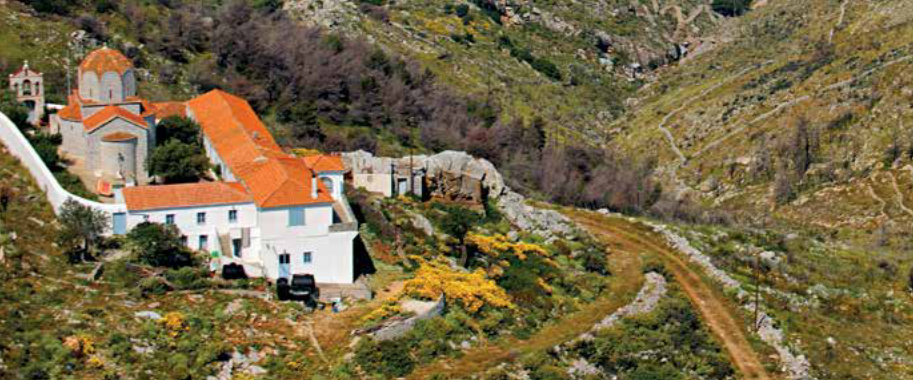
Holy Monastery of Saint Matrona Hydra, 18040
Monastery telephone number: 22980 – 52552
Feast day: October 20, feast of Saint Matrona
On the eastern tip of the historic island of Hydra and on the barren rocky plateau of Ano Zourva, lies the Holy Monastery of the Birth of the Virgin Mary, isolated, one might say, from the world.
We follow the route from Hydra to Agios Nikolaos and, continuing along the dirt path, we come across many ruined stone houses, which were inhabited by Hydra shepherds until the last century.
The road crosses the foothills of Mount Ompori (506 meters), which in Arvanitika means “sheep station.”
On the way to the Monastery of Zourva, we come across two dry riverbeds and many chapels built in the 18th century, which have recently been renovated.
Some of these are the chapels of Agia Paraskevi, Profitis Ilias, and Agios Georgios. The Holy Temple of the Monastery of the Birth of the Virgin Mary was probably built at the end of the 18th century.
The Hydra writer Georgios Sachinis reports that, while talking with the renovator and founder of the current women’s Holy Monastery, the elder spiritual leader Daniel Siakos, he was informed that the holy icon of the Virgin Mary was found in 1776 in a cave on the estate of Eleftherios Giannikis, who founded the monastery.
Today, the icon is located in the katholikon of the Holy Monastery and has been covered with silver and gold leaf.
Transportation is also available by caique, boat, or sea taxi, weather permitting. The trip takes about 45 minutes. From the small port of Lediza, the ascent takes about 45 minutes and is done via a narrow alley with a rough cobblestone path, at a slow pace and with stops.


Holy Monastery of the Birth of the Virgin Mary in Zourva, Hydra, 18040
Monastery telephone number: 22980 – 52715
Feast day: September 12, celebration of the Birth of the Virgin Mary in Zourva
Starting from the church of the island’s patron saint, Agios Konstantinos of Hydra, we follow the uphill path that leads to the Monastery of Profitis Ilias, in about 60 minutes, which was founded in 1813 by monks from Mount Athos “Kollyvades” fathers, on the site of a small monastery that was a dependency of the Holy Monastery of Panagia Faneromeni in Hydra.
Along the way, we encounter a beautiful pine forest and, in the area of “Paleon Kalogreon,” an old women’s monastery. There are benches along the way where you can lie down and enjoy the unique view. At a certain point, the path becomes a cobbled stairway that leads to the gate of the monastery, where the Prophet Elias welcomes you with open arms, looking at you from a mosaic that adorns the gate.
The monastery’s katholikon is a simple basilica with a dome, following the Mount Athos model, surrounded by cells or auxiliary buildings. It was inaugurated in 1815, on the feast day of the Presentation of the Virgin Mary. Today, several old portable icons have been preserved, including the Pantocrator in the dome, the Platytera, and a magnificent wood-carved iconostasis.
The monastery has a rich library, which was specially organized in 1870 by the then abbot, Hierotheos Kostopoulos, while in the courtyard of the Monastery of Prophet Elias there is a cistern with drinking water, a threshing floor, and stables.
In 2000, the last of that distinguished line of Kollyvades of 1813, Father Efthymios Skagos, passed away. Following the actions of the Holy Metropolis of Hydra, Spetses, and Aegina, the monastery was once again staffed by monks from Mount Athos, from the Monastery of Saint Gregory.
During the Revolution of 1821, the monastery served as a prison, and Kolokotronis and other military leaders were imprisoned there for a time.
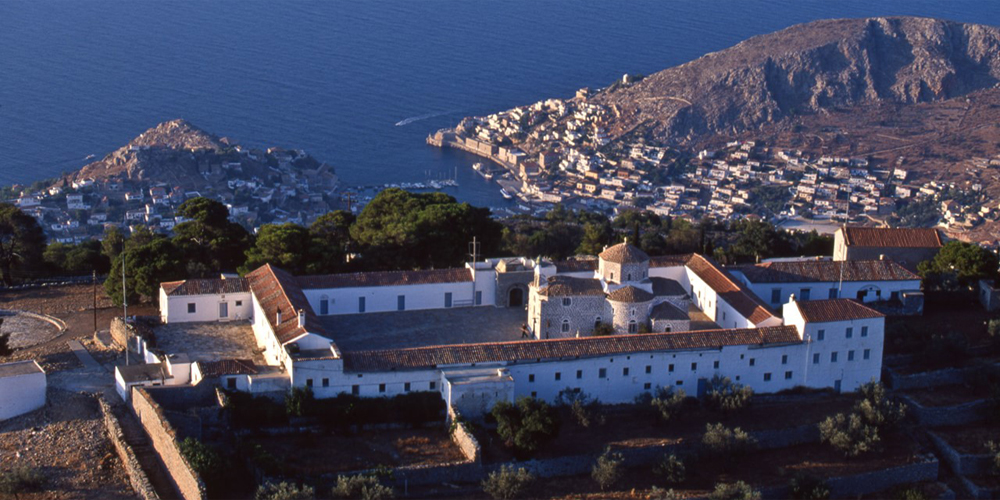
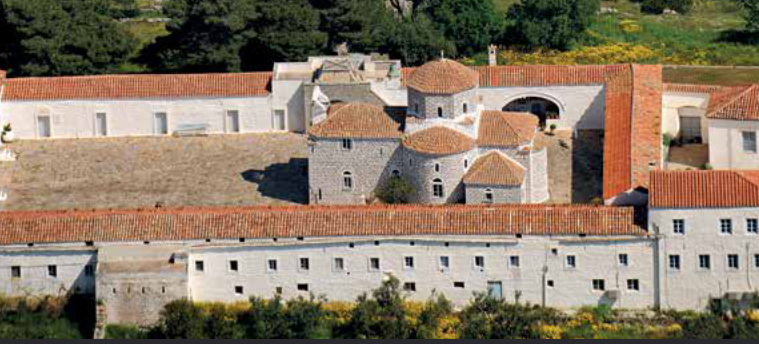
Holy Monastery of Prophet Elias, Hydra, 18040
Monastery telephone number: 22980 – 52540
Feast day: July 20, feast of Prophet Elias
Starting from the church of the island’s patron saint, Agios Konstantinos of Hydra, we follow the uphill path that leads to the monastery of Profitis Ilias and the women’s monastery of Agia Efpraxia, about 60 minutes away.
Along the way, we encounter a beautiful pine forest and, in the area of “Paleon Kalogreon,” an old women’s monastery. There are benches along the way where you can sit down and enjoy the unique view. At a certain point, the path becomes a cobbled path with steps that lead to the Monastery of Prophet Elias.
The Monastery of Agia Eupraxia is located near the Monastery of Prophet Elias at an altitude of about 500 meters with a wonderful view, among pine and cypress trees.
It is stone-built, was founded in 1819, and was a women’s monastery from the beginning. Its small church was built in 1829 by Father Ierotheos Dokos, who dedicated the monastery to Saint Eupraxia.
The Holy Monastery remained famous for the obedience, sisterhood, spirituality, and diligence of the women who lived there. Its woven fabrics were renowned.
In the past, the monastery flourished to such an extent that it staffed three new holy monasteries: Agioi Anargyroi in Ermioni, Agia Matrona in Hydra, and Eleftherotria in Aegina.
Today, three nuns live in the Holy Monastery, and in its courtyard you can see and buy beautiful handicrafts.

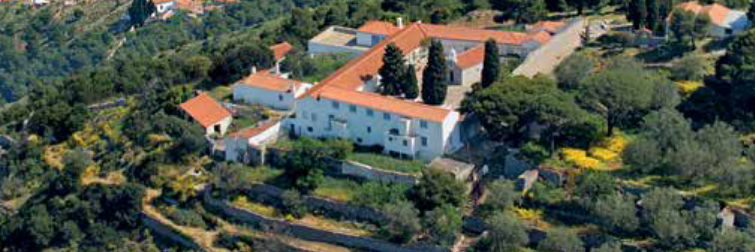
Holy Monastery of Saint Eupraxia Hydra, 18040
Monastery telephone number: 22980 – 52484
Feast day: September 25, feast of Saint Eupraxia
On the beach, after the flying dolphins, the first road on the left, at the first corner of the port (at the “My Crown” exhibition space), leads you to the stadium and then to the pine-covered area of the Monastery of Agia Fotini.
In 1860, the Hydra monk P. Anthimos Hatzikonstantakis, a monk of the Monastery of Prophet Elias, bought the small church of Agia Fotini, on an estate with fruit trees, and founded the Monastery of Virgin Women, where he built additional cells for the nuns.
He died in 1881 and left as his heirs the nuns Eudokia Tsigaris (first abbess) and her nieces Fotini and Makrina Roumani.
In 1921, with the consent of the two nuns, Makrina and Fotini, the ruined chapel was demolished and a new church was built by the late Metropolitan of Hydra, Spetses, and Aegina, Prokopios Karamanos, a new church in the name of the Holy Great Martyrs Fotini and Osia Elizabeth, in the royal style.
In 1924, the nuns Makrina and Fotini Roumani donated and ceded the Holy Church of Saint Fotini and Elizabeth, along with the precious sacred vessels, to the Cathedral of Hydra “Assumption of the Virgin Mary” and in 1925, the nuns donated and ceded the entire estate to the Metropolitan.
In 1938, the last nun, Makrina (second abbess), died, and the Metropolitan ceded the monastery for safekeeping and cultivation to the family of Elias and Zacharo Lebesis, who lived next to the monastery.
In 1955, Metropolitan Prokopios donated the estate and the Church of Saints Fotini and Elizabeth to the nuns Agni Angelopoulou and Christonymfi Yfanti so that they could establish a women’s monastery with Agni Angelopoulou as the third abbess.
In 1963, the Byzantine-style church of Panagia Portaitissa, the miraculous holy icon, was rebuilt and inaugurated in the courtyard of the monastery.
In 1969, following a vow made by the Abbess to the miraculous Saint Nektarios, a second church was rebuilt and inaugurated with the help of donations. It was dedicated to Saint Nektarios and Saints Martyrs Cyriacus and Juliet.
In 1989, the then six-member sisterhood of the Holy Monastery, under the leadership of Agni Angelopoulou, demolished the old east wing and built a new one, which houses a kitchen, cellar, and two dining rooms, while the upper floor houses the nuns’ cells.
Today, the sisterhood has only two nuns, who, in addition to their religious and worship duties, work zealously to maintain and beautify the monastery.

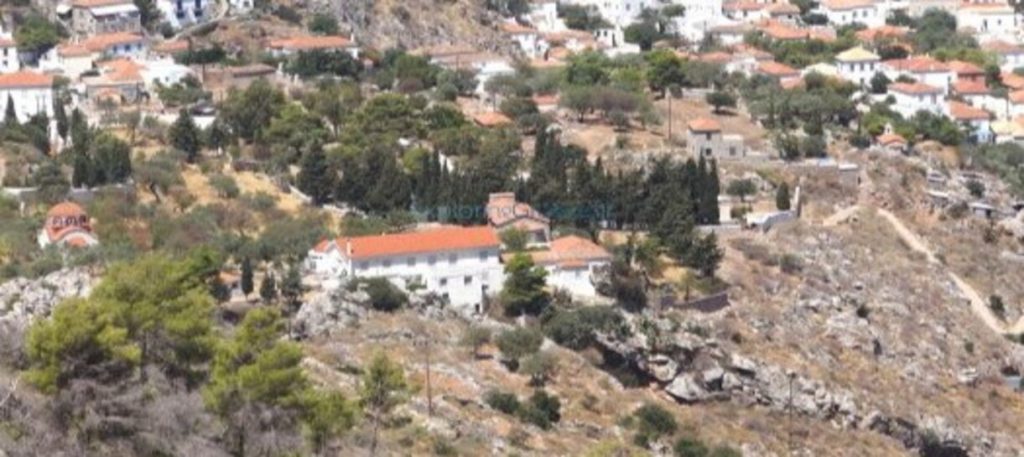
Holy Monastery of Saint Fotini & Elizabeth Hydra, 18040
Monastery telephone number: 22980 – 52209
